#yuta nakayama
Explore tagged Tumblr posts
Text
*RIPS SHIRT OFF* CHERRY MAGIC THE MUSICAL STARRING MATSUDA RYO AND ARAMAKI YOSHIHIKO!!!!!
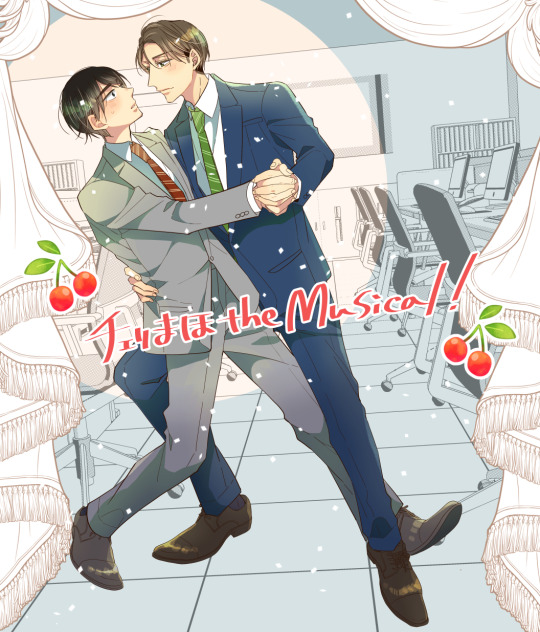



RYO IS IN HIS BL ERA THEY DID THIS FOR ME
BL fans may recognize Ryo from Can I Buy Your Love From a Vending Machine? but he’s known primarily as a butai actor who’s starred in many prominent 2.5D series. I’m biased but he plays fumbling and moe really well and I think he’s perfect for Adachi. Overall, it looks like a solid cast with many staple actors from productions like Tenimyu, Tousute, Toumyu, and so on.
To my knowledge, this is the first 2.5D BL adaptation!! I’m really excited!! It looks like it’s happening in April, so the DVD release will be some time after that.
Cast (via japan-stage-connection)
Ryo Matsuda : Kiyoshi Adachi Yoshihiko Aramaki : Yuichi Kurosawa Daichi Saeki : Masato Tsuge Satsuki Nakayama : Minato Wataya Sho Sakai : Yuta Rokkaku Kaho Takada : Nozomi Fujisaki Yui Hasegawa : Mari Kurosawa Naoya Gomoto : Asahina
#THE BUTAI TO BL PIPELINE#TRASH PRINCE’S BUTAITRASH ERA COMEBACK???#cherry magic the musical#butai#2.5D#cherry magic#japanese BL#jbl#matsuda ryo#aramaki yoshihiko#also i LOVE saeki daichi!! iwatooshi was my toumyu BOY. no he did not have the strongest voice but idc!!!
134 notes
·
View notes
Text
ROAD TO GLORY

FC Machida Zelvia of Japan are currently leading the J1 league after matchweek 27. The newly promoted club has exceeded all expectations, perhaps not even the most optimistic supporter of the club would have expected them to be title contenders in their very first season in the top flight.
Young sharpshooters like Shota Fujio and Se-hun Oh along with Australian international Mitchell Duke have been firing engines in J1 league 2024. Meanwhile Junya Suzuki, Kosei Tani, Gen Shoji and Ibrahim Drešević have been rock solid in defence and of course due credit to Go Kuroda for Machida's incredible run. The club bolstered their squad in the summer transfer window by signing players like Yoshiaki Arai, Yuta Nakayama, Ryohei Shirasaki and Yuki Soma. Even after loaning their highest assist provider: Yu Hirakawa to Bristol City, Machida doesn't seem to slow down in their conquest for the league title.
They have acquired 53 points from 27 games, having won 16, drawing 5 and losing 6 of them. They are closely followed by Sanfreece Hiroshima, Kashima Antlers, Gamba Osaka and the defending champions Vissel Kobe who are placed accordingly on the league table.
It will surely be a test of nerves and grit for FC Machida Zelvia as we slowly arrive towards the business end of the season. Can they do the impossible and lift the J1 title in their first season in Japan's top flight‽
1 note
·
View note
Text
Danh sách đội tuyển Nhật Bản dự Asian Cup 2023
Thủ môn (3): Zion Suzuki (Sint-Truidense), Daiya Maekawa (Vissel Kobe), Taishi Brandon Nozawa (FC Tokyo)
Hậu vệ (9): Takehiro Tomiyasu (Arsenal), Shogo Taniguchi (Al-Rayyan), Ko Itakura (Borussia Monchengladbach), Yuta Nakayama (Huddersfield Town), Hiroki Ito (VfB Stuttgart), Yukinari Sugawara (AZ Alkmaar), Koki Machida (Union SG), Seiya Maikuma (Cerezo Osaka), Tsuyoshi Watanabe (Gent)
Tiền vệ (10): Wataru Endo (Liverpool), Takumi Minamino (Monaco), Junya Ito, Keito Nakamura (Reims), Ritsu Doan (SC Freiburg), Takefusa Kubo (Real Sociedad), Hidemasa Morita (Sporting CP), Kaoru Mitoma (Brighton & Hove Albion), Reo Hatate (Celtic), Kaishu Sano (Kashima Antlers)
#trangtongbong88 #tongbong88 #dailybong88 #bong88 #nhacaibong88 #bong88vietnam
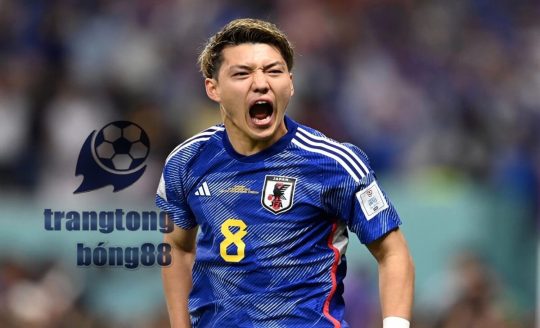
0 notes
Text
Soi kèo bóng đá Stoke City vs Huddersfield, 2h45 ngày 16/2/2023
Soi kèo bóng đá Stoke City vs Huddersfield, 2h45 ngày 16/2/2023 tại nhà cái tặng tiền miễn phí. Dự đoán tỷ số bóng đá giữa Mercredi, pour le choc de Championnat, Huddersfield se rendra au stade de son, Stoke City, qui l’accueillera sur ses terres.
Tham khảo ý kiến của chúng tôi về các số liệu thống kê, số liệu thống kê và các bản nhạc tiên phong của trận đấu giữa Stoke City - Huddersfield (ainsi que les meilleures cotes).
Stoke City sẽ chuẩn bị cho trận đấu thứ 2 sau khi tham gia trận đấu với Hull City ở Championnat nhưng cuối cùng họ sẽ kết thúc với tỷ số 0-0.
Trong cuộc đối đầu tiên phong, Stoke City đã xác nhận quyền sở hữu bóng 55% và 5 giờ nhưng không có 2 cadrés. En face, Hull City, obtenu 9 dự kiến de tir au but not 3 cadrés.
Au cours de ses 6 duels prerécents, Stoke City, sous la direction of Alex Neil, đoàn kịch chemin des filets 11 fois au total, ce qui représente une moyenne de 1.83 buts par rentre.
Tháng tư sau trận thua của con trai dernier đối đầu trực tiếp với Wigan Athletic tại Championnat, Huddersfield đặc biệt là người sáng tạo hơn một chút uy tín của meilleure cette fois-ci.
Trong cuộc đối đầu tiên tiến, Huddersfield đã đăng ký sở hữu bóng ba tỷ lệ 47% và 5 lần dự kiến nhưng không có 2 cadrés. Dans le camp bất lợi, Wigan Athletic, eu 6 tirs au but not 1 cadré. Jack Whatmough (81') vào lưới Wigan Athletic.
Les statistiques ne mentent pas et a encaissé lors de 6 de ses 6 derniers dues, en ayant permis à ses adversaires de mettre 10 but en tout. À l’arrière, Huddersfield một montré ses faiblesses. Những người tham dự nói rằng xu hướng của họ và xác thực sẽ được đổ vào ici.
Si on jette un oeil à leurs rencontres précédentes, en allant jusqu'au 01/01/2020, on s'aperçoit que Stoke City a gagné 3 fois au cours de ces Matchs, Huddersfield đăng ký 1 succès et le nombre de partages était de 2.
Énormément de buts ont été marqués durant ces Matches avec 25 en tout, ce qui représente une moyenne de 4.17 buts par rencontre.
En Championnat, la dernière rencontre entre ces deux club a eu lieu lors de la 3ème journée de Championnat le 13/08/2022. Một trận đấu đáng nhớ nhất của tỷ số Huddersfield Town 3-1 Stoke City.
Ở trận đấu cuối cùng, Huddersfield liên quan đến việc sở hữu bóng với tỷ lệ 42% và 9 lần dự kiến nhưng trung bình là 5 cán bộ. Các quản gia bao gồm Yuta Nakayama (40'), Danny Ward (77') và Jordan Rhodes (86').
De l’autre coté, Stoke City avait eu 18 dự kiến de tir au but avec 5 cadrés. Lewis Baker (56') xuất sắc.
Matt Donohue était l’arbitre du match.
À l'approche de cette rencontre Alex Neil, le manager de Stoke City, n'a aucun souci à se faire en ce qui quan tâm đến điều kiện cơ thể ses joueurs puisqu'il présente une équipe complètement en forme.
Le manager de Huddersfield, Narcís Pèlach, a dû écarter pas mal de joeurs. Yuta Nakayama và Lee Nicholls ne seront pas présents sur le địa hình.
Vào thời điểm mà Huddersfield đến chắc chắn sẽ có hiệu lực đối lập với thương hiệu nếu thành phố Stoke City, họ sẽ nhận được giấy thông hành. Trên pronostique donc une Cuộc đối đầu très serrée et une victoire sur le ratio de 2-1 pour Stoke City au terme de la rencontre. Espérons que ce soit un beau match.
Xem thêm: đá gà trực tiếp Thomo mới nhất hôm nay
0 notes
Text
Japan World Cup squad 2022: Final list of 26 players for national team in Qatar

#FIFA World Cup Qatar 2022#Japan NT#Final list of 26 players#Goalkeeper#Eiji Kawashima#Shuichi Gonda#Daniel Schmidt#Defender#Miki Yamane#Hiroki Sakai#Maya Yoshida#Takehiro Tomiyasu#Shogo Taniguchi#Ko Itakura#Hiroki Ito#Yuto Nagatomo#Yuta Nakayama#Midfielder#Wataru Endo#Hidemasa Morita#Ao Tanaka#Gaku Shibasaki#Kaoru Mitoma#Daichi Kamada#Ritsu Doan#Junya Ito#Takumi Minamino#Takefusa Kubo#Yuki Soma#Forward
0 notes
Photo
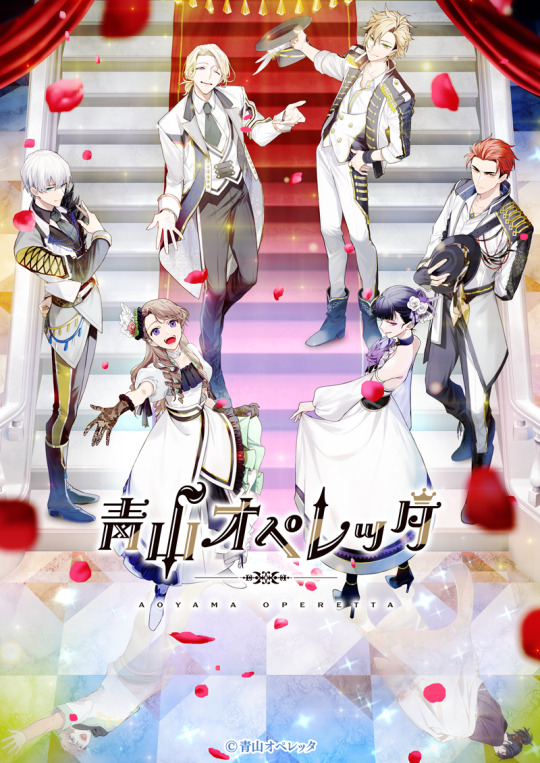

A quick sneak peek before the visual release of the characters from the stage play Aoyama Operetta that will take place next year. All I have to say is...AAAAAAAAAAA!!!!
Nagae Ryouki as Miyajima Asahi
Oohira Shunya as Yachi Kirihisa
Aoyama Operetta is about an all boys theaters (the opposite of Takarazuka Revue - the all female theater) in which a new team is formed. Team Nova. The members of this team enter Aoyama through audition. Most of them have experience performing on stage, but Miyajima Asahi is a complete amateur that only like to sing...yet miraculously he is accepted at Aoyama. You can follow the audio drama for free here. The actors on the stage will the the same ones that give voices to the characters. Alongside the mentioned Nagae Ryoki and Oohira Shuya there will be: Nakayama Yuuki as Sai Takao Oosumi Yuuta as Sakurai Noe Yabe Masaki as Nagae Kaguya Tomotsune Yuuki as Kagami Shouta I can’t wait for the full visual <3
If someone is watching it right now, let me know your opinion about it in the comment section or in private~~ I’m really curious.
#aoyama operetta#nagae ryoki#nakayama yuuki#oosumi yuta#yabe masaki#oohira shunya#tomotsune yuki#drama#stage
24 notes
·
View notes
Photo










endless musical gifsets [3/∞] - Lady Bess
#lady bess#elizabeth i#anne boleyn#mary i of england#philip ii of spain#thomas wyatt#aya hirano#hanafusa mari#Miou Kazune#yuki mirai#furukawa yuta#noboru nakayama#perioddramaedit#asiantheatrenet#musicaltheatreedit#theatreedit#musical series#toho release the forbidden high def version challenge#also a moment of silence for the characters that were sacrificed to the color palette
100 notes
·
View notes
Text
Donten ni Warau (JM, 2018) (Sub. Esp)
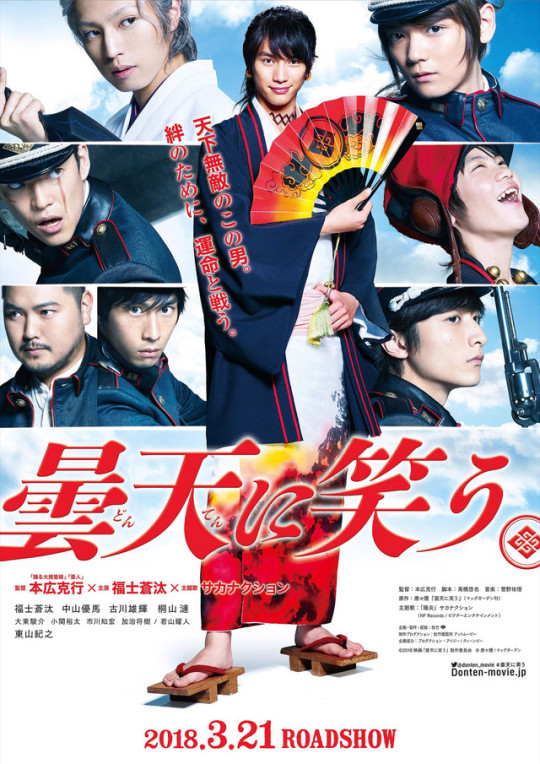
DESCARGAR O VER ONLINE AQUÍ
Título: Donten ni Warau También conocida como: Laughing Under the Clouds (Riendo Bajo las Nubes) País: Japón Género: Fantasía, acción Duración: 94 min. Fecha de estreno: 21 de marzo, 2018 Dirección: Motohiro Katsuyuki Guion: Karakara Kemuri (manga) SINOPSIS La historia se sitúa después de la Restauración Meiji en Otsu, prefectura de Shiga, Japón. Orochi es una serpiente gigante con un poder enorme. La serpiente gigante revive una vez cada 300 años y trae desastre a la gente. Este año es el año del renacimiento del Orochi. La familia Kumou, que sucede el santuario Kumou, tiene 3 hijos. El hijo mayor es Tenka, el segundo Soramaru y el más joven, Chuutarou. Los 3 hermanos intentan bloquear el poder del Orochi. Mientras tanto, las fuerzas especiales Yamainu intentan sellar nuevamente el poder del Orochi para traer la paz a Japón, pero el grupo ninja "Anyaku" del clan Fuma comienza su movimiento para obtener el poder del Orochi y así poder derrocar al gobierno. Alrededor del renacimiento del Orochi se lleva a cabo una batalla a tres bandas entre los hermanos, las fuerzas especiales Yamainu y el grupo ninha Anyaku del clan Fuma. CAST Fukushi Sota como Kunou Tenka Nakayama Yuma como Kumou Soramaru Wakayama Kirato como Kumou Chuutarou Furukawa Yuki como Abeno Sousei Kiriyama Ren como Kinjou Shirasu Daito Shunsuke como Takamine Seiichirou Koseki Yuta como Nagayama Ren Ichikawa Tomohiro como Takeda Takuchou Kaji Masaki como Inukai Zenzou
TRÁILER: https://www.youtube.com/watch?v=w3ABLKXRAR4
#donten ni warau#dnw#live action#fukushi sota#nakayama yuma#wakayama kirato#furukawa yuki#kiriyama ren#daito shunsuke#koseki yuta#ichikawa tomohiro#kaji masaki#proyectos terminados#sub. español
21 notes
·
View notes
Link
Laughing Under the Clouds | Donten ni Warau (2018)
This title will be released on September 12, 2018.

#jMovie#Laughing Under the Clouds#Fukushi Sota#Nakayama Yuma#Furukawa Yuki#Kiriyama Renn#Daito Shunsuke#Koseki Yuta#Tomohiro Ichikawa#Masaki Kaji#Kirato Wakayama#Junya Ikeda#Ryuya Wakaba#Future DVD Release#jMovie_2018_Watchlist
19 notes
·
View notes
Photo



#kenka banchou otome#kbo#rubyblackmoon#nakayama hinako#minowa totomaru#konparu takayuki#mirako yuuta#mirako yuta#hinako#totomaru#konparu#kenka banchou otome: girl beats boys#kbogbb#kborbm
142 notes
·
View notes
Text
Sailor Fuku Hangyaku Doumei: a série Sukeban concorrente do Sukeban Deka 3 que é a mais non sense ja vista

Pra quem não leu meus artigos anteriores sobre Sukeban Deka aqui vai uma rápida explicação: séries Sukeban são praticamente Dramas de TV japoneses que possuem muitos elementos de Tokusatsu,no lugar dos heróis que se transformam temos belas colegiais extremamente fortes capazes de usar armas incomuns e ao invés de enfrentar alienígenas ou invasores do espaço elas combatem bandidos “comuns” e Sukeban significa mulher chefe o feminino de Banchou que é como eles descrevem os delinquentes juvenis,como esses personagens rendem boas histórias graças a incomum postura forte e agressiva faziam muito sucesso nos mangás da década de 60 e 70 e estavam populares na década de 80.Assim a Toei decidiu adaptar um mangá dos anos 70 num drma pra TV usando idols em ascensão pra não apenas alavancar suas careiras como vender CDs da série com as músicas performadas por elas assim tanto a agencia quanto a produtora ganham nisso e nós também pois as séries possuem as mesmas características do Tokusatsu com as Sukeban sendo convertidas em verdadeiras heroínas fortes,belas e cheias de atitude e imponência com boas histórias já que a Toei é expert nisso há anos e Sukeban Deka foi um sucesso tremendo e obviamente outras empresas de olho nisso criaram programas similares,alguns deles podem ser desconhecidos por serem um tanto obscuros,porém pelo menos 6 séries desse estilo são s mais fáceis e acessíveis no momento que escrevo esse artigo.Realmente não sei se existem outras mas falarei daquelas que assisti já que virei fã desse estilo e produção. E uma dessas séries é Sailor Fuku Hangyaku Doumei ou a aliança rebelde do uniforme escolar numa tradução literal.Infelizmente não encontrei nenhuma informação de quem produziu essa série,é difícil achar qualquer informação sobre ela mas a fórmula de Sukeban Deka foi empregada aqui pois temos idols combatendo bandidos porém Hangyaku Doumei apesar de beber da fórmula tenta ter sua pr��pria identidade sendo um pouco similar mas ao mesmo tempo tendo sua cara própria por assim dizer tal qual hoje temos uma infinidade de Battle Shonen de múltiplos estilos. E aqui eles foram bem espertos pois ao invés de usarem a imagem de uma idol em ascensão eles optaram também por colocar uma idol já popular como chamariz para série que no caso é a Miho Nakayama que interpreta a personagem Miho e tudo na série faz acreditar que a Miho é a protagonista porque dão um grande destaque a ela na abertura,ela aparece trajada como Hangyaku Doumei nela,ela parecia ter um papel importante e em todas imagens promocionais da série ela aprece em destaque porém esse foi um “click bait” tão grande quanto um jogo produzido pela Square e dirigido por Hironobu Sakaguchi que criaria mais tarde Final Fantasy onde a atriz estampava o rosto nas propagandas do jogo mas não estava nele.A real protagonista é Yumi essa sim interpretada por uma atriz em ascensão a Nobuko Sendo,a real protagonista da história. Existe um colégio chamado Kokuchou que era um colégio de prestigio e elite comandada pela família da Miho até tudo mudar com a administração de seu pai onde a escola mudou pra uma espécie de escola reformatória de delinquentes juvenis que promete corrigir filhos problemáticos de famílias ricas em troca das mensalidades caríssimas afinal nenhuma família quer que seus membros causem vergonha a sua imagem disposta a fazer tudo pra corrigi-los.Porém o que eles desconhecem são os métodos obscuros da academia de fazer isso pois seu diretor é um ex chefe da Yakuza e seu professor de Kendo gosta de bater nos alunos problemáticos com sua espada de madeira.A protagonista Yumi tem um passado trágico tal qual as heroínas de Sukeban Deka onde sua mãe tenta esfaqueá-la quando criança e deixa um cicatriz em seu peito.Em seguida homens com o simbolo da escola aparecem e essa é a única pista desse mistério,então a garota decide se matricular na escola. Ela ao investigar os mistérios do colégio acaba se deparando com Ruri interpretada por Risa Yamamoto e Kei interpretada por Kyoko Fujimoto que estavam fazendo o mesmo.Percebendo as habilidades incomuns de Yumi as duas decidem formar uma aliança pra investigar a escola formando assim o Sailor Fuku Hangiyaku Doumei onde elas se disfarçam com uniformes brancos e usam peruca e maquiagem pesada pra não serem reconhecidas(se um simples óculos faz o Superman ser irreconhecível por que não?) e passar despercebidas enquanto punem os professores abusivos entre outros criminosos que surgem ligados a escola que maltratam excessivamente os alunos.Já a Miho por ser filha do dono do colégio e ser tratada como uma princesa por todos acaba sendo alvo de um desdem por Ruri e Kei e só as observa de longe ajudando o Hangiyaku Doumei em momentos de perigo estilo Tuxedo Mask com suas rosas explosivas e a única que sabe que é ela é a Yumi que mantém segredo pela animosidade dos outros.O outro personagem é o Yuta que dá suporte as garotas mas como é fraco fica longe dos combates

E basicamente Hangiyaku Doumei trás um caso onde um professor ou algum aluno ou até mesmo criminosos ligados a escola causam algum problema a algum aluno,as grotas investigam durante o dia e quando descobrem o que ocorre elas usam seus disfarce pra punir os malfeitores,usando as armas incomuns de sempre. Ruri usa pincéis,Yumi usa luvas,e Kei usa um lenço marrado em uma corrente que muda de tamanho conforme o diretor quer,e sem dúvida Hangyaku Doumei é a mais insana e nonsense demonstração disso,se você acha absurdo colegiais usando bolas de gude e agulhas de tricô como armas vai achar normal perto de Sukeban Deka porque na série as personagens são fortes mas não fazem nada muito fora acima do limnites do exagero que a série dá,em Hangyaku temos coisas muito absurdas além desses limites e a série trata como se fosse a coisa mais normal do mundo,e por isso os episódios são bem loucos como quando um professor cego com um belo afro é testado pelos alnos que atiram facas defendendo elas com sua bengala com uma caveira no cabo(!) mas que tem o poder de hipnotizar pessoas com suas falas recitadas de inglês ruím. Assim que as pessoas atendem uma ligação eles a recita novamente as deixando em transe fazendo elas virarem assassinas loucas que atacam seus familiares.E el apenas finge que é cego.Em outro temos uma professora sexy estrangeira que deixa os alunos malucos e fazem tudo pra agrada-la porém ela está procurando a portadora das rosas explosivas,na luta final bem no estilo Gorenger a mulher gira e parece dói nada uma máscara em seu rosto como se fosse uma transformação e ela luta com cartas como armas.E como Miho consegue explodir rosas?não importa.Ou o aluno transferido interpretado por um dos membros da banda A-JARI que manipula o vento,e ele não é ninja nem do tipo,é só um músico que também é delinquente. Em Sukeban Deka tínhamos coisas como garotas que saltavam grandes alturas,esmagavam maçãs com as mãos e transformavam simples agulhas de tricô em armas letais mas nunca poderes especiais a não ser que tivesse uma justificativa pra isso como ser ninjas como em Sukeban Deka 3,era um exagero “normal” e que fazia sentido dentro daquele universo insano por assim dizer mas em Hangiyaku Doumei os diretores e roteiristas nem queriam nem saber,extrapolavam e dane-se se faz sentido ou não.

Em relação ao sucesso pelo que eu pesquisei mesmo com uma concorrência pesada com Sukeban Deka parece que a série conseguiu algum sucesso embora nem chegue perto do sucesso da concorrente.em relação ao enredo infelizmente pelo fato de não termos legendas não sei dizer como os mistérios da série são resolvidos com certeza,apenas que a mãe da Miho estava querendo assumir secretamente o controle da academia e estava pensando em um plano pra lobotomizar os alunos,e ela na verdade é a mãe da Yumi,sim aquela que a esfaqueou. Não sei os motivos dela mas no fim após a identidade do grupo ser revelada pouco após a Miho finalmente entrar no grupo e os planos da escola ser desmantelada ela se arrepende e Yumi decide sair da escola e se despede das suas amigas.Em relação a qualidade eu digo que essa série não chega nem perto de Sukeban Deka especialmente da terceira temporada e não é nem por ter metade dos episódios,o Sukeban Deka original tinha 24 episódios e uma ótima trama e desenvolvimento.O problema de Hangyaku Doumei é que a trama dele e seus personagens não são essas coisas,a relação entre as garotas do Hangyaku Doumei é bem rasa,elas tem uma tretinha no inicio,rapidamente se tornam amigas e fica por isso mesmo,a relação é estática e não cresce,a série se concentra muito as investigações.Mesmo episódios focados apenas nelas não são muito interessantes e a série termina sem você ficar marcado por nada,ele é apenas um show muito louco e meio divertidinho mas é só isso,rokla umas cenas de ação bacaninhas,mas nenhuma história interessante,diferente de Sukeban Deka onde a relação entre as personagens e o desenvolvimento crescem a ponto de dar uma ansiedade pra ver o que acontece.Ele me lembra o caso de Shoujo Commando Izumi mas de forma invertida,em Izumi a relação dos personagens é muito bacana e a trama é até legal,porém ele não te muito da loucura das séries Sukeban,já Hangyaku Doumei tem toda a loucura até bem mais exagerada mas o desenvolvimento de personagens e a trama em sí é bem rasa,fora o click bait com a Miho que te deixava numa expectativa pra ela entrar na equipe e só no final que ela de fato se juntava,e ela é uma atriz melhor que as outras e sua personagem poderia ter feito mais,parece que a agenda apertada da atriz que estrelava outro Drama simultaneamente pesou muito também,mas não deixou de ser um pouco de picaretagem dos produtores.Outro erro comum como Izumi é deixar as músicas das atrizes apenas como fundo das batalhas colocando uma banda já popular,o A-JARI com o tema principal,isso ofusca muito as atrizes e a série mostra pouquíssimas canções.Uma curiosidade é que o visual da Yumi com seu disfarce é bem similar a da Satsuki de Kill La Kill.Sabemos que muito de KLK é inspirado e referenciado diretamente de Sukeban Deka mas isso é algo que deixa no ar.
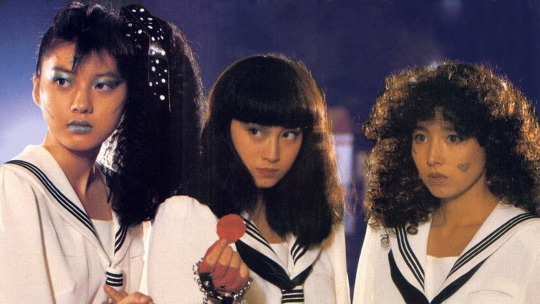
Finalizando,Sailor Fuku Hangyaku Doumei é uma série até divertida com todas as suas loucuras meio non sense,e mostra que não é tão fácil replicar a trama de sucesso.Talvez o fato de ser uma série original ao invés de vinda de um mangá(Hangyaku originou um mangá,fazendo o caminho inverso),ou porque a Toei tem mais experiência como veremos na próxima série desse especial Sukeban
4 notes
·
View notes
Photo


Kenka Banchou Otome BD & DVD
#kenka bancho#kenka banchou otome#hinako nakayama#totomaru minowa#takayuki konparu#rintarou kira#yuta mirako#houou onigashima#official art
163 notes
·
View notes
Photo


Sexual harassment #2
19 notes
·
View notes
Text
About Me:
I’m 19 (turn 20 in April)
My name is Denise but I prefer to be called D or any nickname yall could think of as long as it’s not mean
I’m Latina :)
Pronouns are she/her
I’m a full time college student majoring in psychology and minoring in english
I’m ISFJ and an Aries
Time zone is EST
I’m left handed
I play 4 instruments (trumpet, trombone, piano, drums)
I play volleyball (I’ve been playing for about 5 years now, I’m a middle blocker/backup setter and was captain of my high school team)
I’ve been surrounded by music almost all my life so that’s what inspires me to write songfics
A little fun fact: I almost always cry when I listen to Fuyunohanashi or see any Given edit on tiktok
Kins (bolded = top kin)
Ushijima Wakatoshi (Haikyuu)
Asahi Azumane (Haikyuu)
Mafuyu Sato (Given)
Haruki Nakayama (Given)
Dazai Osamu (BSD)
Tamaki Amajiki (BNHA)
Tenya Iida (BNHA)
Megumi Fushiguro (JJK)
Simp List (won’t make it too long)
Haikyuu: Asahi, Bokuto (my lovely himbo), Semi (my fav rockstar), Kita, Kuroo, Nishinoya, Konoha, Hanamaki, Osamu, Saeko, Tendou, Iwaizumi, Terushima, Hirugami, Shirabu, Inuoka, Kawanishi, Meian
Jujutsu Kaisen: Nanami, Gojo, Getou, Noritoshi, Megumi, Itadori, Nobara, Mai, Sukuna, Yuta and my sweet sweet baby Junpei
Naruto: Kakashi (my first anime crush and I’d let that man do anything and I mean anything to me) and Itachi
2 notes
·
View notes
Text

New Opara radio drama Project Mix 2D characters & 3D

Aoyama Operetta (#青山オペレッタ)
By: Cybird, Avex Pictures and ABC Rights Business
Media Mix : Opara radio drama Project
Website: http://aoyamaoperetta.com
Twitter: https://twitter.com/aoyama_operetta
Aoyama Operetta, A theater company in Aoyama, Tokyo, consisting of only unmarried men.
It has a long history of opera in more than 100 years.
From its origins, it is characteristic that men also play the role of women
In welcoming the memorable "100th generation"
An experimental new team "Nova" is formed
The "100th gen member" selected in the special audition
All the members had too strong personality.
Will they be able to succeed in the first stage insix months?
[Cast]
Miyajima Asahi CV: Nagae Ryoki #長江崚行 (Famale role)
Sai Takao CV: Nakayama Yuki #中山優貴 (Male role)
Nagae Kaguya CV: Yabe Masaki#矢部昌暉 (Male role)
Sakurai Noe CV: Osumi Yuta #大隅勇太 (Famale role)
Yachi Kirigisa CV: Ohira Shunya #大平峻也 (Famale role)
Kagami Shota CV: Tomosune Yuki #友常勇気 (Male role)
Yamesaki Tatsuki CV: Shimono Hiro #下野紘(Cold perfectionist sergeant)
Maki Shinsaku CV: Tone Kentaro #利根健太 (Stronger weirdo director)
Character design: Takita Chihiro
PV: https://youtu.be/FJaRojbuXe8
youtube
#青オペ #Opera #Radio #MediaMix
5 notes
·
View notes
Text
Game of Alice Official Roster

Welcome to EDEN . . . We hope that your time here is a pleasant one..! Synchronization rate is 9...8 %. . . Nearing... completion. . !
Yukai Shinzo - The Knight - Played by Blaze
Yuzuki Akibara - The Cheshire Cat - Played by Sora
Jinghei Jia - The Red Queen - Played by Dia
Rikichi Machida - The Fool - Played by Finn
Mitsuo Ai - The Suit of Hearts - Played by Mickey
Jang-Mi - The Ace - Played by Ash
Yukio Iwata - ??? - Played by Mod Riri
Hotaru Miyamoto - The Rook - Played by Lily
Nariaki Hanyu - The Suit of Spades - Played by Chelse
Spiral - NULL - Played by Eight
Francis Fletcher - The Dragon - Played by Sleepy
Edith Phillipa Chantelle DeBellis - Alice - Played by Desy
Tsubame Akiyama - The Hare - Played by Sissel
Itachi Noda - The King - Played by Pider
Alsou Shengeliya - The Hatter - Played by Kira
Heath Nakayama - The Suit of Clubs - Played by Alli
Happy Sumire - The Trump Card - Played by Munny
Declan Mercer - The Huntsman - Played by Coby
Yuta Yasuhisa - The Jack - Played by Rei
Ran Vasquez - The White Queen - Played by Georgie
Chisei Inukai - The Suit of Diamonds - Played by Shanice
Congratulations to those who are on the roster! Please stand by for discord invites to the official ooc chat for the game as I will be contacting you all shortly! Thank you so much for your time!
18 notes
·
View notes